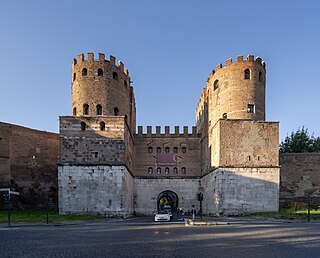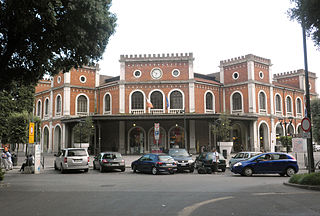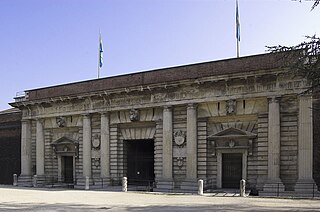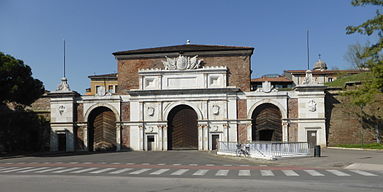
Verona is a city on the River Adige in Veneto, Italy, with 258,031 inhabitants. It is one of the seven provincial capitals of the region, and is the largest city municipality in the region and in northeastern Italy. The metropolitan area of Verona covers an area of 1,426 km2 (550.58 sq mi) and has a population of 714,310 inhabitants. It is one of the main tourist destinations in Northern Italy because of its artistic heritage and several annual fairs and shows as well as the opera season in the Arena, an ancient Roman amphitheater.

A city gate is a gate which is, or was, set within a city wall. It is a type of fortified gateway.

Peschiera del Garda is a town and comune in the province of Verona, in Veneto, Italy. When Lombardy-Venetia was under Austrian rule, Peschiera was the northwest anchor of the four fortified towns constituting the Quadrilatero. The fortress is on an island in the river Mincio at its outlet from Lake Garda.

The Servian Wall is an ancient Roman defensive barrier constructed around the city of Rome in the early 4th century BC. The wall was built of volcanic tuff and was up to 10 m (33 ft) in height in places, 3.6 m (12 ft) wide at its base, 11 km (6.8 mi) long, and is believed to have had 16 main gates, of which only one or two have survived, and enclosed a total area of 246 hectares. In the 3rd century AD it was superseded by the construction of the larger Aurelian Walls as the city of Rome grew beyond the boundary of the Servian Wall.

Michele Sanmicheli, sometimes also transcribed as Sammicheli, Sanmichele or Sammichele, was an Italian architect and urban planner who was a citizen of the Republic of Venice.

The Porta San Sebastiano is the largest and one of the best-preserved gates passing through the Aurelian Walls in Rome (Italy).

Porta Pia was one of the northern gates in the Aurelian Walls of Rome, Italy. One of Pope Pius IV's civic improvements to the city, it is named after him. Situated at the end of a new street, the Via Pia, it was designed by Michelangelo to replace the Porta Nomentana situated several hundred meters southwards, which was closed up at the same time. Construction began in 1561 and ended in 1565, after the artist's death. A 1561 bronze commemorative medal by Gian Federico Bonzagna shows an early plan by Michelangelo, very different from his final design. The façade on the outside of the city was completed in 1869 under the Neo-Classicist design by Virginio Vespignani.

The Devotion of Verona to Venice was a feudal oath of loyalty made by Verona to Venice, via Veronese ambassadors to Venice, pronounced on June 24, 1405. The devotion came after the conquest of the town by Venetian troops during the War of Padua: Venice profited from internal ill-will in Verona against the Carrara rulers of Padua, allowing its army in, helped in part by the people, and forcing the Carrara to flee.

Porta Borsari is an ancient Roman gate in Verona, northern Italy.

The Porta Nomentana was one of the gates in the Aurelian Walls of Rome, Italy. It is located along viale del Policlinico, around 70 m east of Porta Pia. It is now blocked and merely a boundary wall for the British Embassy.

The Milan–Venice railway line is one of the most important railway lines in Italy. It connects the major city of Milan, in Lombardy, with the Adriatic Sea at Venice, in Veneto. The line is state-owned and operated by the state rail infrastructure company, Rete Ferroviaria Italiana that classifies it as a trunk line. The line is electrified at 3,000 volts DC.

The Arco dei Gavi is an ancient structure in Verona, northern Italy, situated at the beginning of the Via Postumia, just outside the Roman walls of the city. Built to celebrate the gens Gavia, a noble Roman family who had their hometown in Verona, the Arco dei Gavi is a very rare example of a privately funded monumental Roman arch.

Verona Porta Nuova is the main railway station of Verona, Italy. It is one of the two stations serving central Verona; the other station, Verona Porta Vescovo, is located at the east of the city.

Porta Sempione is a city gate of Milan, Italy. The name is used both to refer to the gate proper and to the surrounding district (quartiere), a part of the Zone 1 division, including the major avenue of Corso Sempione. The gate is marked by a landmark triumphal arch called Arco della Pace, dating back to the 19th century, although its origins can be traced back to a gate of the Roman walls of Milan.
Verona Porta Vescovo is a railway station serving the city of Verona, in the region of Veneto, northern Italy. The station opened in 1847 and is located on the Milan–Venice railway. The train services are operated by Trenitalia.

Porta Palio is a gate or portal of the former outer medieval walls of the city of Verona, Italy. It was designed and built during 1550–1561 by the architect Michele Sanmicheli.

Porta San Giorgio was a gate or portal of the former outer medieval walls of the city of Verona, Italy.
The following is a timeline of the history of the city of Verona in the Veneto region of Italy.

Porta Nuova is a gateway to the historic center of Verona, built between 1532 and 1540. It was designed by architect Michele Sanmicheli. Giorgio Vasari remarked on the gateway in his work Le vite de' più eccellenti pittori, scultori e architettori, stating that it was "never before any other work of more grandeur or better design."

















